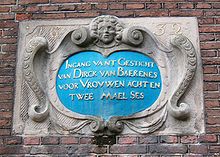Hofje



A Hofje ( Dutch , small courtyard ) is in the Dutch- speaking area a residential complex consisting of individual houses and communal facilities, which is built around a central courtyard and was donated by Dutch and Flemish wealthy people as old people's apartments for their servants. Around the same time, religiously orientated courts emerged in the Middle Ages , the beguinages , which offered single women the withdrawn, socially imposed life devoted to the faith without having to enter a monastery and belong to a specific religious community.
Today they are almshouses -Apartments no longer rent-free, but still often rented to vulnerable older citizens. But the accommodations are also in great demand with students and artists. Some apartments are now privately owned as condominiums.
Emergence
The Hofjes had their origins in medieval forerunners of old people's homes for former servants and houses for single women. The name arose from the arrangement of the residential complex, which is grouped as an architectural ensemble consisting of individual small houses and outbuildings around a communal inner courtyard, mostly designed as a kitchen garden. In addition to the kitchen garden, there were toilets, washing facilities and a kitchen as communal facilities; the individual living and sleeping areas of the residents were in the small, picturesque row houses.
An important characteristic of the Hofjes was the common housekeeping and a close house community. The Hofje is usually separated from the adjoining houses and complexes by walls or moats and is only accessible via one or two gates that used to be closed at 10 p.m. Each Hofje had a porter / caretaker who worked for the foundation to which the Hofje belonged. The foundations were run by wealthy patrons who were called "regents". They also decided on the influx of residents and assigned them the apartments.
In addition to facilities for women and retirement homes for employees, social facilities for the elderly, the poor and the sick were soon created.
Nowadays the houses have been rebuilt, provided with their own sanitary facilities and kitchens, and are grouped around a green area or an ornamental garden. They are popular accommodations for students, artists and young people. In their character, the facilities are similar to the cooperative settlements of the early 20th century in major European cities.
Retirement benefits
Before Willem Drees, the Netherlands had no old-age pensions . The elderly were mostly dependent on the church or patrons or their employers and dependent on free accommodation and the most economical housekeeping possible.
(Almost) only for women
Single women, unmarried or widowed, who did not want to go to the monastery and take a vow, found a home in the beguinages. However, mostly older women also lived in the "normal" Hofjes. For older men there was the Oudemannenhuis .
Virtuous life
Living for free was a favor, but beneficiaries were expected to lead righteous, godly lives. Many Hofjes had their own church, regular church attendance was compulsory; staying away overnight is only possible with the consent of the regents.
Received plants
Hofjes are typically Dutch, but they can also be found in Belgium . Most were built between the 13th and 19th centuries. Well-preserved systems can be found in Amsterdam , Alkmaar , Haarlem , Hoorn , Leiden and The Hague . In Groningen or Naaldwijk the Hofjes are called "Gasthuis" or "Geesthof" as in other northern places.
nowadays
Living in Hofjes has long since ceased to be free, but it is still predominantly single, older women who live there, even though increasingly younger people, such as students or artists, are interested in such a tiny house and a still largely communal everyday life, and so are the owners get the opportunity to rent. In The Hague, in particular, there are now many privately owned courtyard apartments. In Haarlem, a former Hofje is now a brothel . Apart from that, Haarlem is considered to be the “Hofjes town” along with Leiden, as they probably have most of the preserved facilities.



